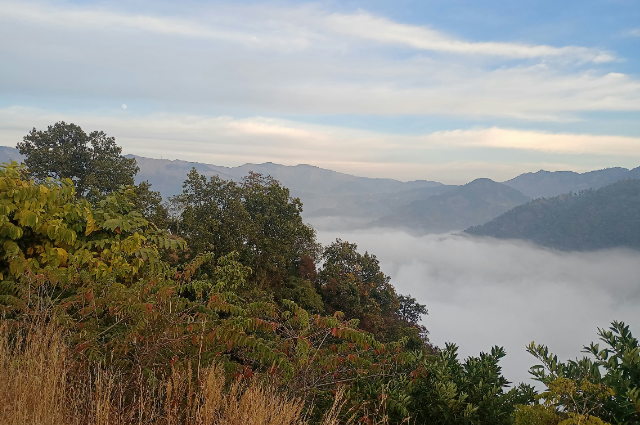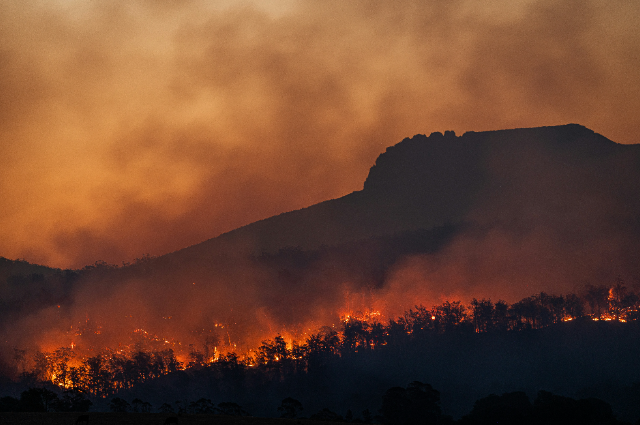
Photo by Pawan Kukreti on Unsplash
When I was little, my grandfather used to wake up before dawn and take me on long walks through the oak and pine forests in our village "Shankot" in Chamoli. He said the forest was a temple without —one where you spoke in whispers and listened more than you talked.
Now, those same forests echo with the sounds of bulldozers, sirens, and falling trees.
A State in Flames, a Nation Unbothered
Between 2017 and 2023, Uttarakhand reported over 6,000 forest fires, consuming more than 80,000 hectares of green cover. But it wasn’t just the fires. Roads widened for pilgrimage tourism, hydropower projects blasted into mountains, and so-called “smart” urban development plans cleared entire belts of native flora.
From Joshimath sinking in 2023 to frequent landslides in Pauri, Chamoli, and Tehri, the mountains are quite literally crumbling under the weight of “development.”
But the media barely covers it. No breaking headlines. No national mourning. Just silence.
The Push for Concrete Pilgrimage
One of the most ecologically destructive projects in Uttarakhand is the Char Dham Highway Project, a 900-km stretch aimed at connecting four sacred Hindu shrines—Badrinath, Kedarnath, Gangotri, and Yamunotri.
Sounds spiritual, right?
In reality, the project has resulted in the felling of over 56,000 trees, destabilized mountain slopes, and violated multiple environmental safeguards. Landslides have increased. Natural springs have dried up.
Yet, it was deemed “of national importance” and exempted from key environmental assessments.
If temples are meant to be places of reverence, why are we destroying the very mountains that hold them?
When Development Becomes Displacement
Ask the villagers in Raini, the birthplace of the Chipko Movement, about development.
In 2021, a glacial burst upstream caused a massive flash flood that destroyed the Rishi Ganga hydropower plant, killed over 200 people, and displaced thousands. And yet, new dams are still being sanctioned on similar terrain.
Locals say, “We used to worship the rivers. Now we fear them.”
The very people who protected these forests decades ago are now watching them die—and losing their homes in the process.
Who Gets to Decide What Progress Looks Like?
This is the question that gnaws at me.
Does development mean high-speed highways or safe drinking water in the hills?
Does it mean cement hotels or the preservation of rare mountain biodiversity?
Does it mean religious tourism or resilient villages that don’t slide into the valley every monsoon?
In most cases, the decisions are not made by those who live in the forests—but by those who fly over them in helicopters.
The Youth Inheritance: A World on Fire
As a 17-year-old growing up in Uttarakhand, the grief is personal.
I’ve seen forests I used to play in vanish. I’ve smelled the bitter, chemical scent of fires that rage for days, while authorities send two men with a hose to fight flames stretching across acres.
I’ve lost count of the number of species I no longer see. The calls of the Himalayan monal, the rustle of barking deer—replaced by the grind of JCBs.
Forest Fires: Man-made and Mismanaged

Photo by Matt Palmer on Unsplash
Uttarakhand isn’t just accidentally burning—it’s being allowed to burn.
Studies show that most forest fires are caused by human activities—illegal timber trade, slash-and-burn agriculture, and shockingly poor forest management.
And yet, the forest department is understaffed, villagers are rarely trained in disaster response, and no systemic prevention model exists.
Instead, every year, we watch fires engulf the hills and blame it on “dry weather.”
Ecological Grief Is Real
There’s a word I recently learned: “solastalgia.”
It means the emotional pain of seeing your home environment degrade before your eyes.
I feel it every time I go back to my village and see a patch of grey where it used to be green.
I feel it when I hear that a river has been diverted.
I feel it when relatives tell me, “Kya karein, yeh toh vikaas hai” (“What can we do? This is development.”)
But is it really?
A History of Resistance
Uttarakhand isn’t new to protest. In the 1970s, women like Gaura Devi led the Chipko Movement, hugging trees to stop loggers from cutting them down. The world watched. India changed.
But today, the resistance is fragmented. Young people are discouraged from “activism.” Environmentalists are branded “anti-development.” Tribal voices are erased.
And yet, in the shadow of this erasure, something is stirring again.
The Youth Are Watching
From students protesting the cutting of trees in Dehradun’s Canal Road, to young villagers using drones to document illegal quarrying in Almora, youth-led eco-activism is rising.
We are learning to speak the language of resistance—through film, articles, petitions, and social media. We are planting trees, but also planting ideas.
Because we know the truth: we’re not just fighting for trees—we’re fighting for our future.
Whose Loss Is It Anyway?
The real tragedy is not just ecological. It’s spiritual.
To lose a forest is to lose stories.
To lose a mountain is to lose a mother.
To lose a river is to lose prayer.
These aren’t abstract losses. They’re cultural, generational, and irreversible.
When the forests of Uttarakhand fall, it is not just a tree that dies—it is a way of life.
What Can Be Done—Still
Pause and Assess Projects: Environmental Impact Assessments must be made mandatory, transparent, and independent.
Educate Local Youth: Equip students and villagers with climate education and disaster response training.
Promote Eco-Tourism: Instead of mass concrete pilgrimage centers, promote smaller, sustainable homestay and trekking models.
Strengthen Forest Governance: Invest in training and expanding forest staff; empower gram sabhas to monitor deforestation.
Amplify Indigenous Voices: Protect the rights and knowledge of communities who’ve lived in balance with nature for centuries.
Conclusion: A Choice We Must Make
Uttarakhand’s forests are not just “green cover” on a satellite map. They are memory, medicine, mythology, and meaning.
As a daughter of these hills, I can’t stand by while they vanish.
I may not hold power in parliament. But I hold a pen. A voice. A heart still full of love for these trees.
Let this article be a seed.
Let it grow into action.
Because development should not come at the cost of devastation.
Because the mountains deserve more than monuments—they deserve protection.
And because when we lose a forest, we don’t just lose oxygen. We lose ourselves.
